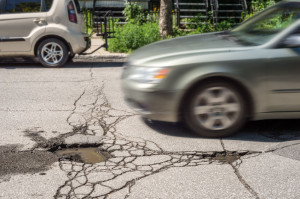 Every spring, the same problem pops up when the snow melts: potholes. They’re the bane of property managers and drivers alike, causing damage to vehicles and property. But potholes are more than just an inconvenience. They’re a serious and expensive issue. According to a 2022 study by AAA, pothole-related vehicle repairs cost American drivers about $26.5 billion annually, with the average repair bill totaling almost $600 per incident (AAA Newsroom, 2022).
Every spring, the same problem pops up when the snow melts: potholes. They’re the bane of property managers and drivers alike, causing damage to vehicles and property. But potholes are more than just an inconvenience. They’re a serious and expensive issue. According to a 2022 study by AAA, pothole-related vehicle repairs cost American drivers about $26.5 billion annually, with the average repair bill totaling almost $600 per incident (AAA Newsroom, 2022).
Why do potholes always form in the spring?
Every spring, potholes seem to appear almost magically as the snow melts and the temperature rises. This happens because when temperatures rise, the snow melts, allowing water to enter small cracks in the pavement. But then at night, when the temperature drops again, the water freezes, expanding and widening the cracks, and eventually forming a pothole.
Springs in Utah are especially tough on pavement. It’s common for the weather to warm up during the day, only to drop again at night, and we regularly experience spring snowstorms after everything has melted. It’s the perfect mix of conditions for potholes to form. It’s no wonder it feels like potholes suddenly appear overnight!
The cost of ignoring potholes
Potholes cannot be ignored, as they will only worsen over time and potentially lead to vehicular damage for which property owners may be liable. But they aren’t exactly cheap or easy to fix either. According to SealMaster, repairing a single pothole can cost between $35 and $50, not including labor and equipment expenses (SealMaster, 2023). So what should property owners do? Invest in preventive maintenance practices to prevent potholes from forming.
Preventative maintenance: asphalt vs. concrete sealing
Regular pavement maintenance is crucial for safeguarding roads, parking lots, sidewalks, and other surfaces against damage. Key maintenance practices can include crack sealing, surface patching, and drainage improvements. These practices can identify early signs of wear and prevent minor issues from escalating into major problems.
However, one of the most effective measures that property owners can take is to invest in sealing their pavement surfaces. Sealing creates a barrier that reduces moisture penetration and enhances the pavement’s resistance to freeze-thaw cycles, helping to prevent cracks, potholes, and surface wear. It’s a great way to extend the life of the pavement surface and avoid more costly repairs, but there are key differences between sealing an asphalt surface and a concrete surface.
Asphalt Sealcoating
- How often does it need to be done: Every 2–5 years, depending on traffic levels and weather conditions.
- How does it work? Sealcoating restores the asphalt’s essential oils, protects it from UV damage, water infiltration, and oxidation. It also refreshes the appearance of parking lots and roadways.
- How effective is it? Studies show that properly sealed asphalt surfaces can extend their lifespan by 5–10 years (Pavement Interactive, 2023).
Concrete Sealing
- How often should it be done: Every 3–5 years, or sooner if cracking or surface damage appears.
- How does it work? Concrete sealing prevents water and chemicals (like deicers and salts) from penetrating and damaging the surface. It also reduces the risk of freeze-thaw spalling.
- How effective is it? Proper concrete sealing can double the life of sidewalks, curbs, and gutters (American Concrete Institute, 2023).
Project spotlight: Snow College Campus
Our team recently completed a proactive pavement maintenance project at Snow College in partnership with Utah’s Division of Facilities Construction and Management (DFCM). The goal was to improve the accessibility, safety and durability of the pavement surfaces for the Ephraim and Richfield campuses. Some of the actions our pavement team recommended included:
- Asphalt sealcoating: We proactively applied a seal coat to preserve the existing asphalt areas in good condition, to extend the lifespan of the pavement surface, and to reduce weather damage over time.
- Full-depth asphalt repairs: We recommended removing and replacing the most severely damaged pavement areas. Part of this process involved reinforcing the base of the repair surfaces to withstand vehicle loads, water damage, and temperature fluctuations for a longer period.
- Concrete upgrades: This project also required us to move and replace damaged sidewalks, waterways, curbs, and gutters to enhance drainage and pedestrian safety.
- Accessibility improvements: Several outdated and inaccessible sidewalks were removed and replaced with accessible ramps to meet modern ADA standards. We also updated the accessibility signage.
Our work at the Snow College Campus was extensive, but much needed. We replaced aging pavement and sidewalk surfaces to enhance accessibility and improve the safety of students and faculty using the campus. The preventive measures, such as asphalt sealing, will protect the new and improved pavement surfaces for the next few years and hopefully prevent a plethora of potholes and cracks from appearing next spring.
Let us help you protect your pavement surfaces
Every year, potholes appear on roadways and in parking lots across our home state of Utah with the arrival of the spring thaw. We can’t control the weather or how it affects pavement surfaces, but with preventative maintenance measures like sealing in place, we can mitigate the effects of our harsh spring weather. So if you’re looking for a partner to help you keep your pavements and parking lots in good condition for years to come, reach out to our pavement consulting team. We can recommend preventative maintenance measures or full-scale repairs that will be worthwhile investments. With our help, you can spend less money on costly pothole repairs each year and extend the lifespan of your pavement surfaces. Contact us today to schedule a consultation for your project with our team.








